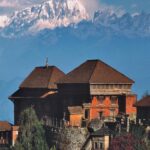Kailash Mansarovar Yatra : Significance
- Kailash Mansarovar Yatra has special meaning for Hindus, Buddhists, Jains and Bonpos
- Many people from India, Nepal and Tibet visit Kailash-Mansarovar each year
- The journey is not an easy feat – difficult road, high altitude, extreme weather
- The reward, however, is priceless
Mount Kailash (6638m) and the lake Mansarovar (4590) are sacred pilgrimage destinations to people of four different religions – Hinduism, Buddhism, Jainism and Bon. Kailash and Mansarovar are located adjacent to each other – in the southern part of the Tibetan Plateau and in an area not far from the trisection of Nepal-India-Tibet Autonomous Region.

Mount Kailash and lake Mansarovar
- Water – in form of large rivers, flows down to the southern plains of the subcontinent from the area
- Mansarovar is thus mother of people down south and Kailash is their father
The lake and the area surrounding the mountains are the source of four large rivers in the Indian Subcontinent – Ganga (Karnali), Brahmaputra, Sutlej and Indus. These rivers feed the subcontinent from completely different directions – Brahmaputra stretching to the easternmost part and Indus flowing in the westernmost part. Lake Manasarovar and the vicinity of Kailash have irrigated and given life to most part of the subcontinent and are its life blood.
People therefore view Mansarovar as their mother (janani) becuase of her role in feeding and nourishing them. Kailash, abode of lord Shiva – who destroys all evils and fear, is viewed as their father.

Kailash Mansarovar Yatra – Visits and subsidies
- Many state governments in India provides subsidies to visit Kailash-Mansarovar
- Nepal is making efforts to better facilitate visits to the region
- People of all age visit the place and take part in the ‘Holy Dip’ and ‘Charan Sparsh’
Despite the challenges aplenty, Kailash Mansarovar Yatra is one of the most sought after treks because of the aforementioned reasons and the stunning beauty of Tibet. The risks are high but the joy, satisfaction and thrill is limitless. Even old people, whom you would not count for such a grueling trek to the high Himalayas, take part in the yatra and perform the ‘Holy Dip’ at Mansarovar and the ‘Charan Sparsh’ (touching the feet) of Kailash.
Many Indian states like Kerala and UP provide subsidies to visitors who take part in Kailash Mansarovar Yatra (KMY) . Nepal, through which some easier routes to the region lies, is also opening newer avenues and making infrastructural developments in the northern reaches of Karnali region to help people with their visits.
Read More: Religious significance of Kailash Mansarovar Yatra











